
Give your dog a designated digging area and restrict him unsupervised access to the areas where you don’t want holes to be dug if you want to completely stop undesired digging.
Digging is among many dogs’ favorite pastimes when it comes to their natural behavior. Digging is frequently discouraged for dogs who live with people, which is unfortunate.
There are many reasons why dogs dig holes in the ground:
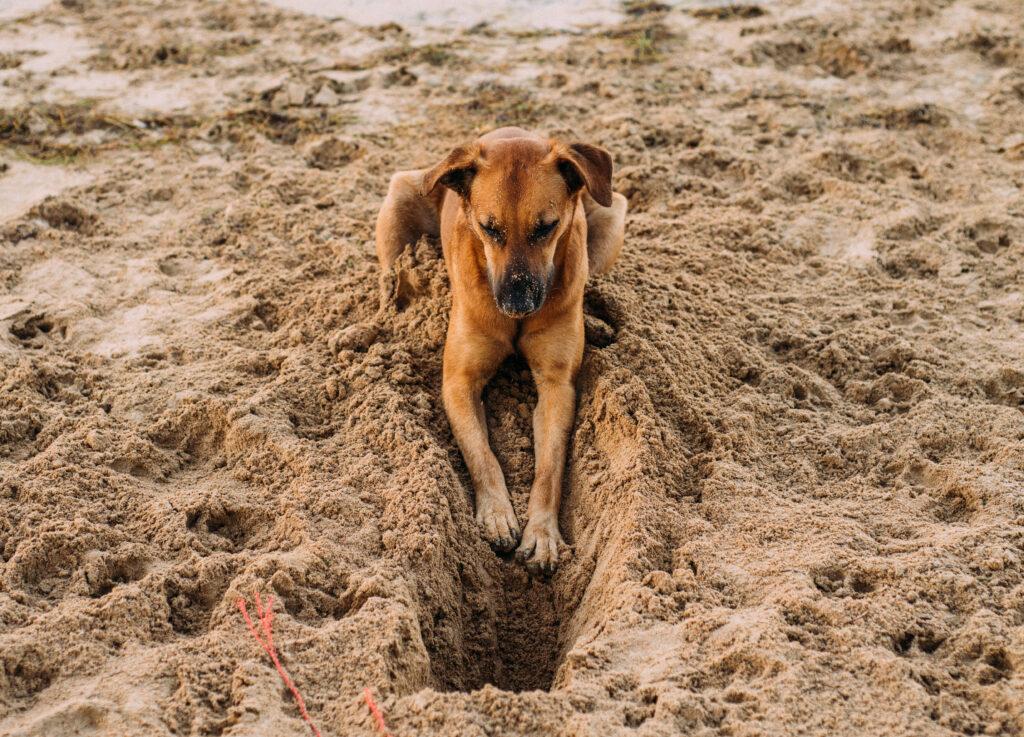
Avoiding digging entirely is the best solution. Until you’re sure your doggy can amuse himself without digging, don’t leave him outside unattended. Look around your yard to find the best sites for digging, such as gopher mounds, regions with loose ground, or damp areas that are conducive to digging. Of course, some dogs may dig wherever they feel like it, but removing the temptation makes it simpler to focus your dog’s attention on better habits.
If you must leave your digging doggy alone in the yard, use management to help stop practice sessions for the undesirable activity. If your dog likes to dig, you might want to consider a secure enclosure like a dog run or utilize a reliable exercise pen that is set up to prevent access to certain places. Just while she is learning, though; it won’t last forever!
It’s a good idea to assess your dog’s overall enrichment honestly. Does your dog go for daily walks outside of the house and/or yard? Is the path always the same? Do you vary your routine by doing some exercise while you walk? Does your dog ever accompany you on errands to new (dog-friendly) locations if he is comfortable in public? Dogs frequently dig when they’re bored. Ask him honestly what else he has planned for the week to see if you can shake things up a bit.
If your dog has a history of digging up stuff, try some of the following:
Create a digging pit by filling a plastic wading pool or a child’s sandbox with sand or dirt. Compared to dirt, sand leaves less of a mess. bury the toys your dog enjoys most. Show him the reward pit and assist him in finding it with excitement. Don’t forget to replace the toys buried within the pit and continue assisting him in finding the treasures. The “hides” may get smaller and more difficult to spot as he improves.
Digging holes at random? Try replacing the majority of the dirt in the hole, adding some of your dog’s waste on top, then covering it with the remaining earth. Digging for fun and discovering waste can be very unpleasant for some dogs. As your dog tries out new digging techniques, you’ll probably need to repeat this process a few times, but for many dogs, the regular experience of uncovering waste will cause them to reevaluate their backyard behavior, especially when combined with your efforts to give them more enjoyable activities.
You find it difficult to poop in your dog’s favorite holes. Use the same method, except instead of excrement, use a piece of chicken wire that has been cut to fit the hole’s surface area.
We advise creating a trough along the fence for fence diggers, then filling it with massive, upright stone pavers. Another option is to bury an 18-inch-tall chicken wire trip about a foot beneath the bottom of a wooden fence.
Most crucial, keep in mind that behavior doesn’t alter suddenly. It may take up to a few months of consistency before you notice a noticeable difference in your dog’s digging, so you’ll need to be consistent in your efforts to lessen it using a combination of teaching and management. Avoid digging yourself a deeper hole by giving up too soon!
If you are interested in purchasing a Dog Knee Brace from us please check out our store and if you are interested in join our Facebook Page click here.
One of the first things you’ll do to help your dog adjust to his new home is potty training, and there are several different approaches you can take. To ensure success for both you and your dog, try these seven tips.

Decide where you want your new friend to “go” outside the house before you start potty training. Do you have a yard? Point them in the direction of a place that is easy to reach from the door. Dogs living in apartments should also be able to recognize open, accessible natural terrain that isn’t blocked by people or vehicles.
Once you’ve chosen the location you’ll take your dog during this potty training phase, be sure to take them there each time they need to go outdoors. Consistency is key while teaching a puppy to use the bathroom since dogs can scent their territory.
Although your new puppy may not be able to communicate with you in your native tongue, they will nonetheless make an effort to let you know when they need to go potty. Fortunately, there are several indicators you can watch for. As soon as you see them, take your dog outdoors to their designated potty training area:
When your dog exhibits the final symptom on the list, it might already be too late. So that they are aware that their customary space is up for grabs before they go in the wrong location, be prepared to open the door nonetheless.
Plan beforehand so you can swiftly take your dog outside if you see any of these symptoms. Keep a leash directly by the door so you can quickly lead the pet outside. Keep in mind to direct your dog to the same location each time they need to urinate. Once they are aware of the location of their designated bathroom, they will go there on their own.
Maintain a routine for all meal and snack times while potty training a dog. This is beneficial in two ways: The first benefit of planned meals is that they will teach your dog when to expect meals throughout the day. Second, if you feed your dog at regular intervals, you may follow up and take them to their designated potty training area in the knowledge that they’ll be prepared to relieve themselves shortly after they finish eating.
It’s likely that your dog will urinate frequently if they consume a lot of water. During the potty training stage, take your puppy outside soon after drinking so that they are in the appropriate location at the appropriate time.
Take your dog outside as soon as you wake up, after each feeding, and whenever you notice signs that they might need to relieve themselves. A lot of dogs have a bowel movement 30 minutes after eating. Until you have a better understanding of how frequently your dog does potty, take them outside every hour to prevent accidents. Based on their age, the following are some rough guidelines for how long puppies can “hold it”:
While small breeds with smaller bladders may require more frequent bathroom breaks, big breeds have a stronger ability to wait. Most dogs can wait seven hours or more by the time they are seven months old. They ought to know how to alert you when they need to go outside by that age. Always take your dog out before you go to bed to prevent 3 a.m. wake-up calls or morning surprises.
Everyone enjoys being told when they are doing a good job, and your dog will benefit greatly from this encouragement. It doesn’t matter if you give them treats or just pat them while saying “excellent work.” Just make sure they understand how much you value their attempts to conduct themselves properly. To teach the command “go to the bathroom,” think about identifying the deed. For instance, you might tell your dog to “take a break” before engaging in play.
Puppies prefer not to go potty close to where they eat or sleep. By crate training your dog, you can use it to reinforce housetraining. A puppy can easily relieve themselves in one part of a bathroom or laundry room while sleeping and playing in the remaining areas. If you need to use the phone or check your email while keeping an eye on your young dog, keep them in their kennel.
They will let you know if they need to use the restroom because they won’t want to mess up this place. Put them back in the kennel when you reach home if they play unproductively while outside. A crucial lesson that every puppy should learn is that if they mess up the kennel, they will have to temporarily live with it.
Accidents happen frequently during house training. When your dog needs to go outdoors to the designated pee place, quietly direct them there immediately away. Punishing a puppy could exacerbate the problem and lead to more accidents at home.
Clear the space right away. Ammonia should be avoided since it smells a lot like pee. While disinfecting, bleach cannot get rid of odors. Your dog will probably go potty there again if they smell feces in your house. Use an enzymatic cleanser or odor neutralizer made especially for pet excrement to clean the stained area. While it dries, keep your dog away from the area.
When encountering new people or animals, puppies may squat out of excitement or respect. Before meet-and-greets, give them bathroom breaks to prevent a mess. Take frequent bathroom breaks while traveling as well. If you want to board your dog while you are away, make sure to provide the facility detailed instructions to ensure consistency. Restart house training if you move to a new residence. Limit them to one area of the house, show them where the new toilet is, and give them praise when they behave well.
Many dogs don’t like going outside in the rain or don’t like going potty in the snow. A puppy may be terrified of the cold and rain for the first time, but even older dogs prefer to potty in comfort. To provide some weather protection, keep an umbrella close at hand.
Create a trail to your dog’s chosen bathroom location so they can go without exposing their tails to the bitterly cold ground. Increase their reward for using the restroom in poor weather by giving them twice as many treats. This will lessen the likelihood of unpleasant surprises beneath the piano bench. Even the best-trained dogs are more likely to have accidents in the house if they are overly anxious, stressed out, or afraid. Consult your veterinarian to rule out any health issues whenever your house-trained dog has a number of accidents.
Not all dogs pick things up at the same rate. By eight or ten weeks old, some puppies are experts at house training. Other puppies, such those of toy breeds, may take longer to grasp your expectations and may not show consistency until they are a few months old. In most circumstances, all dogs can learn to relieve themselves in a permitted area with your patience, encouragement, and persistence.
If you are interested in our Posh Dog Knee Brace you can purchase one through our Store or if you have any questions you can reach us on our contact page. If you would like to learn more about us you can also check out our Facebook Page and community.
After they poop, dogs will occasionally use their hind feet to scratch or kick the ground. Give them freedom to; we don’t know why they do it, but it seems they like it.
It’s a routine ritual. A dog urinates or defecates, then scuffs dirt, grass, or gravel into the air in what appears to be an accomplishment or at the very least, a mark of celebration. What motivates canines to behave in this way?
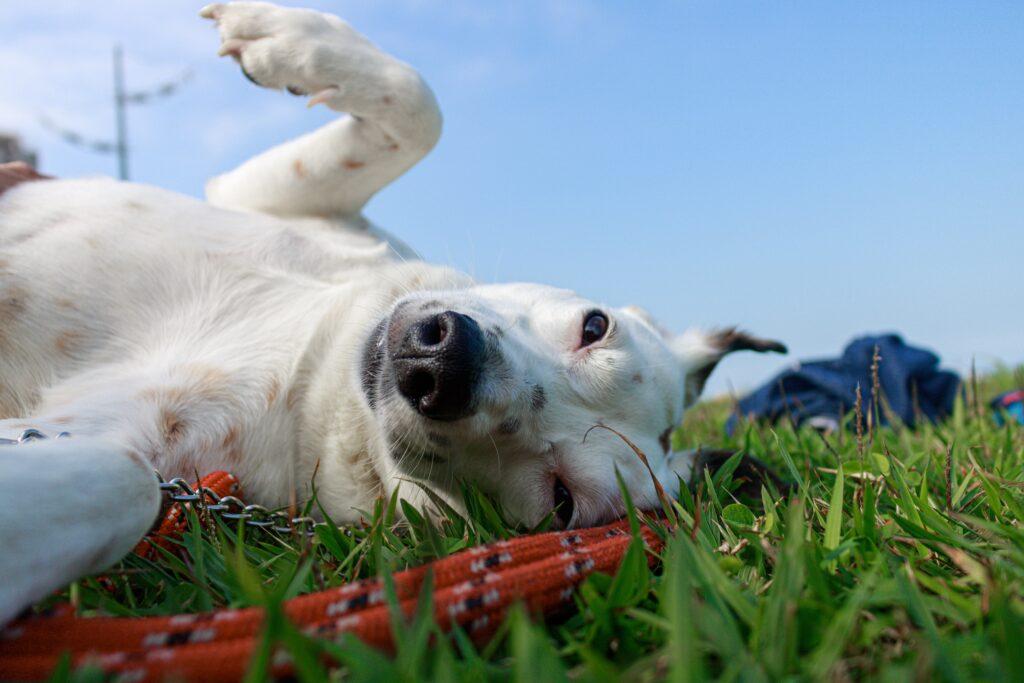
According to certain research, males engage in this behavior substantially more frequently than females when other dogs are present.
Dogs may do this for a variety of reasons, depending on the people present and what they are attempting to convey through visual, olfactory, and aural cues. He claims that dogs who exhibit this behavior appreciate it and that it appears to have significance for them.
If your dog’s grass kicking harms your yard or causes other issues, find entertaining diversionary strategies and encourage other habits until this one is under control. If not, wait until your dog has finished speaking before moving on with your walk. This will allow them to finish their message.
The Posh Dog Knee Brace is a 100% custom Dog knee brace, hand made only for your Dog. We make our custom brace with no casting. Our state-of-the-art brace for Dogs is very durable, waterproof, sand proof, and easily adjustable by customers.
If you are interested in a Posh Dog Knee Brace you can contact us on our contact page or you can order from our store. If you would like to check out our community page on Facebook click here.
How frequently to feed your dog is one of the most contentious topics in the world of dog owners. Do you fed them breakfast in the morning, then lunch and dinner, or does that run the risk of overfeeding them? Do you fed them all at once or do you wait until the end of the day? No matter your dog’s age, take a look at the finest food options to keep them nourished and healthy.
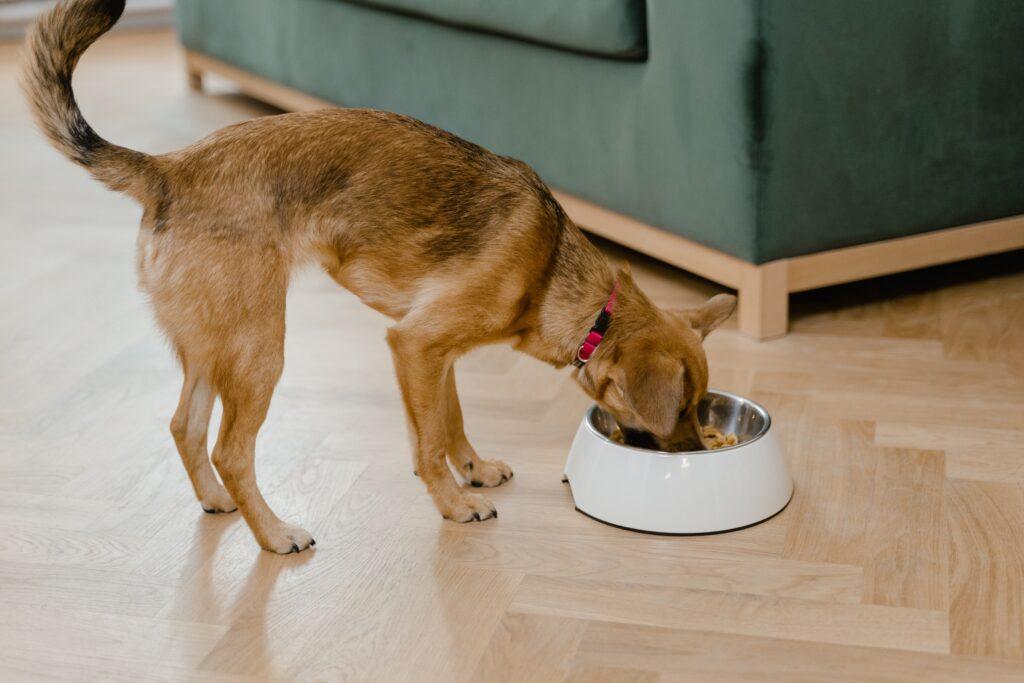
Ideally, you ought to give your dog food twice daily. Most crucial, these two meals need to be served every day at the same time. They will eventually develop a regular schedule for going to the restroom each day. You can also keep an eye out for any health problems. Dogs who are feeling under the weather might not eat as much. As a result, if your dog follows a regular eating schedule, any problems will be obvious.
Ensuring they don’t receive more food than what your veterinarian advises is crucial. For optimal feeding, it’s essential to speak with your veterinarian because some food labels might be deceptive. Remember that less priced dog feeds may not provide your dog with the same nutrients as products that adhere to the Association of American Feed Control Officials (AAFCO) nutritional requirements since they contain fillers like maize and brewers rice.
The feeding method that most dog experts advise against is letting your dog graze on a full bowl of dog food all day. This choice could be the simplest for dog owners with a hectic schedule, but your dog won’t gain anything from it.
When dogs have constant access to food, there is a greater likelihood that they may overeat, which can cause complications as they age like excessive weight gain or health problems like heart disease or diabetes.
Young puppies actually require a number of smaller, distinct meals in order to develop into healthy, powerful animals. As early as three to four weeks old, puppies are ready to begin eating solid foods. At that young age, it can be necessary to feed them up to five times per day. When using dog foods designed specifically for puppies, just keep the portions modest. The right amount of food for your puppy’s age and breed should be determined by your veterinarian.
When your dog reaches the age of six weeks, you can cut back on the number of meals to three or four per day. No matter what breed your dog is, three meals a day should be sufficient for them after eight weeks. Keep in mind that pups that are teething can start eating less for a while. Puppies between the ages of three and six months typically experience this.
Due to inactivity or health problems, dogs’ appetites may decline as they get older. They might not have the same amount of energy to run around as they did when they were younger, thus they won’t require as much food. You might wish to switch them to a senior dog chow that has fewer calories at this stage of their life, or just start feeding them less frequently.
Some older dogs are more vulnerable to a variety of ailments. In order to keep them healthy as they age, they will need to keep an eye on their eating patterns and maintain a healthy weight.
Please keep in mind that dogs have sensitive stomachs when feeding your pet. Frequently changing pet food brands could make them uncomfortable. If you decide to switch, make sure to do so gradually over a few weeks so they have time to adjust to the new flavor and recipe.
Overall, your dog is the finest resource for determining its needs. You can be overfeeding them if they appear to be in wonderful health but aren’t finishing all of their food. They may be deficient in important nutrients if they are constantly hungry.
It’s critical to understand what your dog eats. The quantity, rate, and manner in which they digest their meal will give you a decent idea of their health, level of activity, and general contentment.
If you are interested in any other information you can reach out to us on our contact page or visit our Facebook Page.
Here is the best advice and tips on how to bathe a dog, from selecting the right shampoo to washing a dog’s head.
A little shampoo, some water…. How challenging can bathing a dog be? Occasionally, harder than you’d expect. Regular dog baths are an essential element of pet care, regardless of whether your dog enjoys them or flees when you say “B-A-T-H.”

You usually don’t need to bathe your dog more frequently than once a month, unless your pet had spent the afternoon playing about in mud puddles. Breed-specific factors come into play here; for example, longer-coated dogs may need more regular bathing or even visits to a groomer. Consult a groomer or your veterinarian if you’re unsure how frequently to soap up your dog. (IMPORTANT TIP) Giving a bath once a month is crucial, though.
Dogs develop a completely new layer of skin cells every 30 days or so. “The aged cells therefore slough off. Dander and other similar products are produced in this way. Therefore, regular grooming or bathing helps to reduce that dander.
Your initial choice will probably be where you will bathe your dog. Your decision will probably be influenced by the size of your dog. A little dog might fit in the kitchen sink for a bath, but a large dog will need more room. Some pet owners like dog-specific bathtubs, whether they are standalone units, built-in units, or located in a DIY dog bath facility. Fur and filth can be prevented from blocking your family bathtub by using a designated dog bath space. But it’s also acceptable if you want to bathe your dog in the household bathtub. Simply pick a location where you can bring your dog in and out of the cleaning area without risk.
Then, make sure you have all your supplies and tools close at hand before turning on the faucet. You don’t want to have to go around your house chasing a wet dog in search of conditioner. Of course, you’ll need towels, shampoo, and conditioner on your supplies list. Just in case, you might also want an eye wash and a non-slip bath mat.
You need to start with the correct supplies if you want to give your dog a thorough bath. Make careful to use shampoo designed exclusively for pets. Dogs’ skin has a different pH than people’s. Therefore, they are more alkaline. It can irritate someone’s skin if they use shampoo designed for people.
Puppy-specific shampoo may be a good idea when bathing a puppy. Puppy shampoo’s pH is similar to that of a dog’s eyes, so if any goes in there, it won’t bother the eyes as much.
Ask a groomer what products they use if you’re unclear of the ones to choose for your particular dog. Use a gentle shampoo, a shampoo made to treat the ailment your dog is having, such as itchy skin, may be the best option.
The crucial next step is applying a conditioner to your dog’s coat after shampooing. When doing your own grooming at home, you should always follow up with a conditioner because using shampoo strips the skin and hair of many of their natural oils. Therefore, your conditioner both hydrates the epidermis and seals up every cell on the exterior of the hair shaft itself. “Basically, using the conditioner is rehydrating.”
The real fun starts once you have selected the ideal location and ready-to-use supplies. Here is our bathing process:
One of the trickiest steps in giving your dog a bath is washing his head. Avoid getting water or soap in your dog’s eyes, nose, or other delicate body parts. Delaying this step until after the bath and suggests wiping your pet’s face with a washcloth.
Your dog’s head and face should be gently washed with the washcloth dipped in soapy water. After that, rinse with clear water using a fresh washcloth. Make sure all of the soap is removed from those locations.
You should try to avoid the eye area as much as possible when applying shampoo, even if the shampoo is intended to be gentler on puppies’ eyes. Have an eye wash on hand to use if shampoo does get in your dog’s eyes. Moistening eye goobers on your dog before gently removing them with a toothbrush.
Even though some dog breeds adore the water (golden retrievers come to mind), many dogs tremble at the mere sound of the bath tap going on. Give your dog lots of praise while bathing him to help combat this. Treats are preferable to praise. When your dog next sees you gathering the dog shampoo, make sure he associates it with good things.
Having a companion hold the dog while you give him a wash is also beneficial. Additionally, if at all feasible, begin bathing your dog as a puppy to get him accustomed to the experience.
First, try your best to towel-dry your dog. Then, put a human hairdryer to a medium or cool setting or use a hairdryer designed specifically for dogs. When your dog is drying off, start brushing him. As long as your dog doesn’t shiver excessively or get the chills, you might also let him air dry.
“Every 10 or 15 minutes run a brush through them as they’re drying and that’ll help avoid mats or help separate mats if they have them,” if you’re air-drying your dog.
Your dog will look and smell better after a bath. Additionally, you will feel good knowing that you did something good for your dog’s wellbeing and appearance.
If you have any questions you can reach out to us through our contact form or you can check us out on Facebook.
Dog Toys are not a luxury but rather an absolute necessity for dogs and other pets.
The well-being of your dog depends on its toys. When you must leave your dog at home, toys keep them entertained and reassure them when they’re anxious. Even the development of some negative behaviors in your dog can be delayed with the use of toys.
Dogs are frequently more than happy to play with whatever object they can get their paws on. To avoid any “unscheduled” activities, you will therefore need to monitor your dog’s playtime carefully.
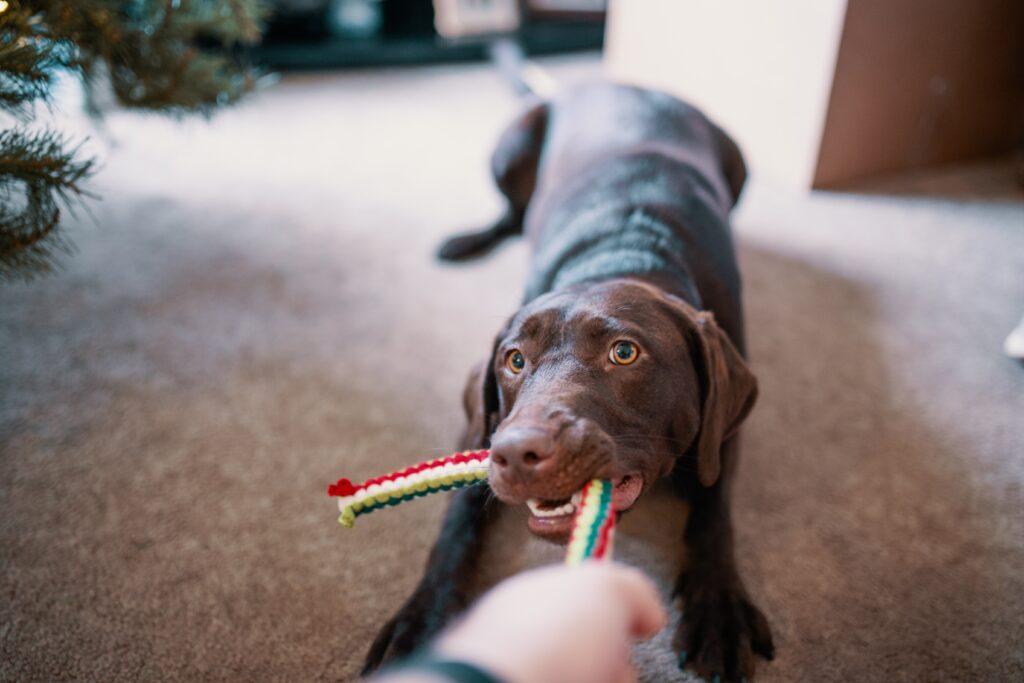
The size, activity level, and preferences of your dog all play a part in determining whether a dog toy is safe or dangerous. The environment in which your dog spends their time is another factor to take into account. The safety of any particular toy cannot be guaranteed, however we can provide the following recommendations.
Dogs typically find the most dangerous things to be the things that they find most appealing. Remove all strings, ribbons, rubber bands, children’s toys, pantyhose, and other potentially ingestible materials from your home to dog-proof it.
Make sure the dog toys you buy for your dog are the right size. Smaller toys run the risk of being ingested or getting stuck in your dog’s throat.
If you don’t watch your dog playing with squeaky toys, they can eat the squeaking object since they feel the need to find and destroy it.
Toys that aren’t “dog-proof” should be avoided or modified by taking out any ribbons, strings, eyeballs, or other pieces that could be chewed off and consumed. Dog Toys that are tearing or starting to shatter into pieces should be thrown away. Check the labels on plush animals to make sure they are suitable for children under three and don’t have any poisonous fillings. Nutshells and polystyrene beads are examples of problematic fillings, but even “safe” fillings aren’t actually digestible. Though certain soft dog toys are more durable than others, keep in mind that they are not invincible. Soft toys ought to be washable in the machine.
If you’re considering giving your dog a rawhide chew toy, make sure to ask your vet which ones are secure and suitable for your dog. Give these toys to your dog only when you can keep an eye on them as they may present choking concerns.
Rawhide is a byproduct of the brutal international fur trade in large quantities. Consider toys made of extremely firm rubber, which are safer and last longer, as a kinder substitute.
Industry insiders categorize dog toys into many categories since they are now so common and diversified. Here are five categories for toys:
Tennis balls are excellent fetching toys for dogs, but they don’t hold up well to chewing. Tennis balls that have been eaten through should be thrown away since they could choke your pet.
An old t-shirt, pillowcase, towel, or other piece of filthy laundry, especially one that smells like you, can be quite comforting to a dog. Be aware that diligent fluffing, transporting, and nosing may result in the item being.
Puppies develop the impulse to chew on everything between the ages of 12 weeks and 6 months as their baby teeth fall out and their adult teeth begin to erupt through their gums. Providing children with teething toys will increase their comfort and protect your hands, shoes, and furniture. Rubber toys and sturdy nylon bones can withstand weeks of chewing without shattering into fragments that could be ingested. You may purchase specialist puppy teething toys that can be frozen and have calming textures printed on them.
Only have a few toys available at once to ensure weekly toy rotation for your dog. Maintain a range of accessible kinds. You might want to keep a favorite toy for your dog out at all times if it is soft.
Give your dog toys that may be used in a variety of ways, including carrying, rolling, shaking, and comforting.
Toys that are “found” are frequently considerably more appealing than toys that are clearly introduced. Your dog will burn off excess energy by playing the game of “find the toy” or “find the treat” without the need for much space.
Your dog should have a lot of engaging toys. Because dogs want active “people time,” interactive play is crucial for strengthening the link between you and your pet. Toys that promote the attachment between a person and their pet include balls, flying discs, and other items.
Your dog can release pent-up mental and physical energy from boredom by concentrating on a particular task, such as continuously returning a ball, or Frisbee or playing “hide-and-seek” with treats or toys, in a constrained period of time and area. Interactive play provides a chance for socialization and teaches young, hyperactive, untrained dogs about proper and improper behavior, such as jumping up or being mouthy.
For more information you can each out to us via our contact form or visit our Facebook Page.
Read reviews check out our Google Reviews online. Click Here
Keep your pet off of Santa’s bad list right up until his arrival! It’s the holiday season!
It’s likely that your furry family member will be present to take part in the celebrations when everyone is gathered around the tree to open gifts and spread joy and laughter. However, your pet might find the ideal moment to cause some trouble while everyone is preoccupied with presenting gifts and playing with new toys.
Your tree is probably going to be the focal point of the celebrations this year, but it may also be a tremendous temptation for your dog! Make careful to hang the shiny tinsel, bright lights, and ornaments in the shape of tennis balls out of reach of your animal pets. Some mischievous dogs could still attempt to jump on the tree, so leaving something noisy, like crumpled aluminum foil or a bottle filled with tiny objects, can alert the dancer of imminent danger. Additionally, if you have a live tree, make sure to pick up all of the fallen needles since if consumed, they can cause serious stomach discomfort in your pet.
Your pet’s health and safety are at risk from holiday plants other than trees. Keep in mind that plants like holly, mistletoe, and poinsettias are harmful to dogs, so keep them out of reach!
It could be a good idea to inspect all electrical decorations, both indoors and outdoors. To prevent your furry pals from getting caught and creating a mess, tape the wires to the wall!
When it’s time to unwrap presents, be sure to have a garbage bag on hand to dispose of wrapping paper, twine, and tape as soon as they’re no longer required.
It might be wise to confine your pet to a comfortable area with access to water if you’re expecting a large number of guests, at least until the ruckus dies down. Before your guests arrive, you might want to review your dog’s obedience commands; we don’t want Grandma to trip over a huge, puppy hug! Additionally, it’s crucial to let your visitors know they shouldn’t give your pets any table food. You wouldn’t want your dog to eat too much and have to spend the rest of the holidays taking care of their stomach ache, even if some foods aren’t particularly dangerous to them.
The team at Posh Dog Knee Brace hopes that these simple reminders allow your pet to have fun with the family this holiday season! If you would like any information on our brace you can reach out to us via our contact form or visit our Facebook page.

Read reviews check out our Google Reviews online. Click Here
We are used to reading that regular walking will keep your dog healthy. How frequently do you walk your dog though? How often should you do this? How much activity do dogs actually require? How can I make the most of a dog walk? Find all of those answers right here!
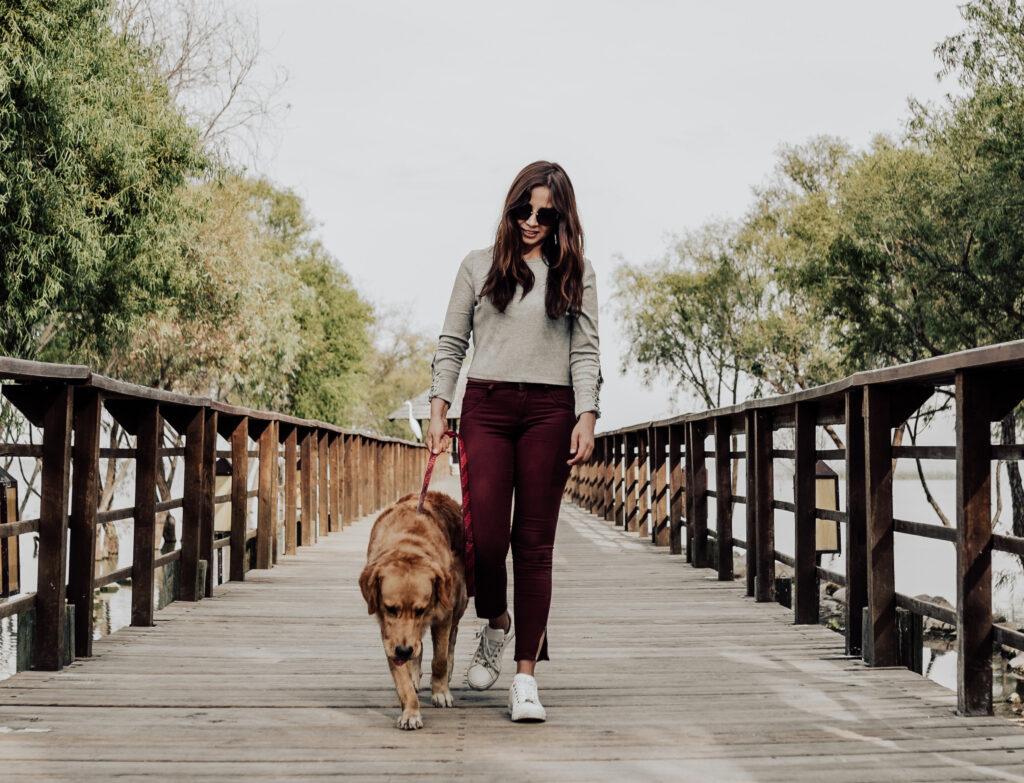
It’s generally advised to take your dog on a walk for at least 15 minutes three to four times every day. However, this may change depending on your dogs:
Smaller dogs might benefit from just one daily stroll, but high-energy dog types will need multiple walks. Is one of those breeds your dog? Are you an active person who wishes to spend more time exercising with your dog? Perhaps you are unsure of the precise amount of exercise your dog need. A trip to the vet is advised in that situation. They will be pleased to offer you practical hints and walking guidance tailored to the particular conditions involving your dog.
Every dog belongs to a distinct breed group, and every breed has unique exercise requirements and restrictions. Giving you a good idea of how much activity to aim for, it’s simple to stay on track after your daily goal has been established.
The amount of sleep your dog receives is as crucial to how much walking you should undertake. After all, a full day of action calls for a restful sleep. Learn your dog’s sleeping patterns, check to make sure they’re getting enough (quality) sleep, and determine if anything seems off. For instance, excessive sleeping could be a warning that you should consult your veterinarian.
If you’re a really active person, these high-energy breeds will fit your lifestyle:
Outdoor activities are the ideal method to develop a relationship with these animals. Your dog will make the trip more enjoyable whether you choose to stroll, hike, or run.
These dog breeds require more exercise than others:
If your dog falls into one of these categories, aim to push them beyond their physical limits while also testing their training and cognitive abilities. The dogs in these categories will find ordinary games dull, so feel free to get inventive!
Did you realize? These dogs need a minimum of 2.5 hours of intense activity per day.
This can readily be translated into at least four daily walks of 20–25 minutes each. Due to their high intelligence, dogs in this category should also be given mental challenges. A minimum of 30 minutes should be set up each day for intelligence game sessions with them. Make sure to outfit these puppies with an activity monitor so you can follow them on all of their outside escapades.
Terrier dogs come out as little, vivacious, strong-willed, and trainable. Although there are only a few dogs in this pack, they nevertheless require a lot of exercise.
Advice: Terriers require at least 1.5 hours of exercise each day.
A reasonable walking routine might involve three 20–25 minute walks each day. For this group, you might want to add some games that need cerebral exercise. It should be difficult enough for 20 minutes a day to keep them active.
Breeds belonging to this group, such as:
Definitely need a challenge in the activities. For them, a minimal amount of daily walking and exercise is one and a half hours. Since these dog breeds enjoy running as well, feel free to begin a running exercise with them as long as you take your time and account for your dog’s age.
It’s important to remember that dogs in this group should take at least three daily walks of at least 30 minutes each, in addition to engaging in cognitive activities.
Chihuahuas and other small dog breeds are typically what we refer to as companion animals today. Avoid subjecting these low-energy breeds to long periods of strenuous activity. Instead, allocate shorter amounts of time for enjoyable activities like games and regular strolls to keep the kids active.
Overly active dogs, such as those with short hair, can have detrimental effects. Since they have less fur, they are more prone to respiratory problems and easy overheating. Take these breeds on quick, uncomplicated strolls. Activity monitor your dog to keep tabs on your tiny dog’s daily exercise to make sure it doesn’t exceed recommended levels.
Watch out: These dog breeds only need two daily, brief walks.
There are several benefits for your dog in frequently walking with you. Some of these explanations have to do with your dog’s health, while others have to do with its training. While following you and moving at your pace while on a leash, your dog might learn discipline.
Are there any considerations you should make when walking your dog? Safety comes first as usual.
Only when you are confident your dog won’t run away and you are in a safe, unpopulated place should you try off-leash dog walks.
Don’t punish your dog if they do manage to escape. Your dog must not identify your return with any sense of wrongdoing or resentment. Keep your dog on a leash at all times if you find that they have a tendency to run away. Make sure to teach your dog the fundamental safety commands as another safety advice. They are not only simple to teach, but they can shield you and your animal companion from risky circumstances.
A dog parent’s life includes taking their dog for walks frequently. A short stroll helps your dog behave better in social situations and strengthens the connection you share with your dog. You may have fun while working to keep your dog healthy if you view dog walks as enjoyable times of the day.
Another way to lessen destructive chewing or scratching is to take your dog for a walk (should this be an issue your dog is facing).
However, the advantages extend beyond your dog! In fact, going outside to spend time with your dog can improve your general wellbeing and level of fitness. Daily walks can reduce your risk of developing diabetes, strengthen your bones, and lower your blood pressure. So, why are you still waiting? Get your dog outside and walking!
For more information you can reach us on our contact page or visit our Facebook page for more tips.
Read reviews check out our Google Reviews online. Click Here
Hey guys, this is Nikki, lead veterinary technician with Posh Dog Knee Braces. Today, lets discuss weight management in our spayed and neutered pups. It is well known that spaying and neutering, after a certain safe age, is recommended by almost every veterinarian. It is very important in the prevention of overpopulation, and other health concerns, however, it also predisposes our pups to obesity. Unfortunately, many vets are so quick to schedule your dog for surgery, and there is simply no information given to the owners as far as where to go now.
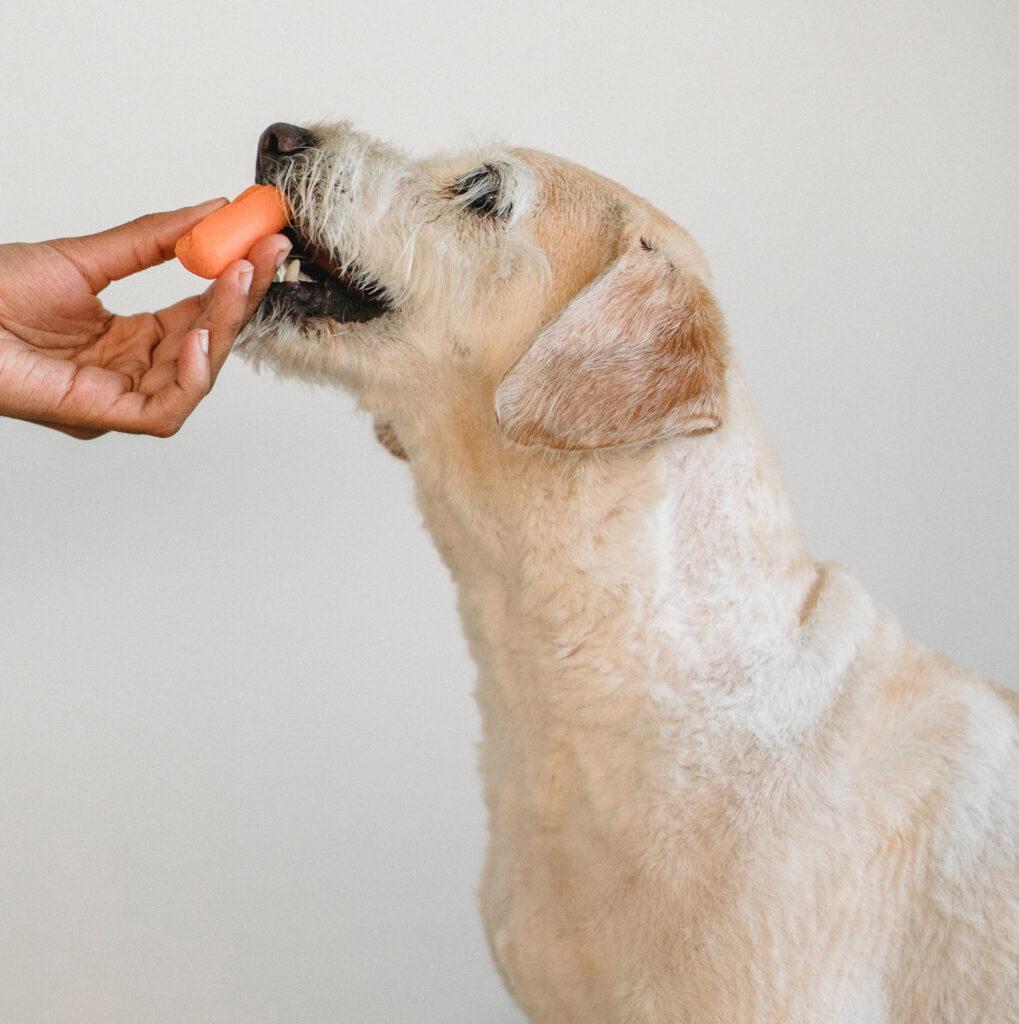
So, now we have this relatively healthy dog, young and probably more active, and we just took away the hormones that helped keep their weight in check. Post spay and neuter, their metabolic energy decreases significantly. This means that we need to also be cutting back the calories, by at least 25%. The other issue, especially with females, is that the hormone estrogen helps to keep their appetite at bay. Taking this hormone away can give your dog an increase in appetite, which is bad in a patient that needs to decrease the calories taken in per day.
So, now you go back in for your annual checkup, to find your baby has gained weight. The veterinarian possibly tells you that your dog needs to go on a weight loss diet, or be given less food per day. So, now you have a dog that just went through major hormonal changes, and has increased food cravings, yet you are feeding them barely any food.
Sound familiar? This equals out to an unhappy dog, and in return and unhappy owner. So, what is the solution, because it is also essential that we spay and neuter to be good pet parents, and do our part to prevent overpopulation.
This is where it is time to get proactive. Feel free to include your veterinarian in your plan, as you will need a way to weigh your dog every 2-4 weeks to check their weight. The good news is this is free😊 Now, it is time to implement the proper spay and neuter diet. For those that feed a raw diet already, you should not need to make any real changes.
The key is to increase protein and fiber, but keep in mind it needs to be healthy fiber. There are a few expensive brand foods marketed to spayed and neutered pets that the first ingredient is chicken by product. Double yuck! Just keep in mind that carbs will not help with weight loss. Foods with lots of rice for example are not meant for weight loss. It may be bland, but it will cause weight gain.
Try discussing with your veterinarian before you plan to spay or neuter, ask them to help you develop a proper diet to keep your dog healthy for years to come! This also will help prevent issues with joints potentially in the future.
Please let me know if you have any questions, you can contact us through our contact form or visit us on our Facebook page.
Read reviews check out our Google Reviews online. Click Here
This is about half of the people I speak with on a daily basis. Puppies are wonderful, and really do bring our families and other dogs joy, but sometimes that comes with a cost. Whether you bring home the puppy before an injury on your older dog, or after, we still need to be careful when they play. Rough play, such as puppy jumping on their back or playing tug of war, can result in new injuries, or aggravating an older injury. Puppies bring on a youthful playing with our older dogs, which is fun to watch, however, it can encourage injuries, so please be careful.
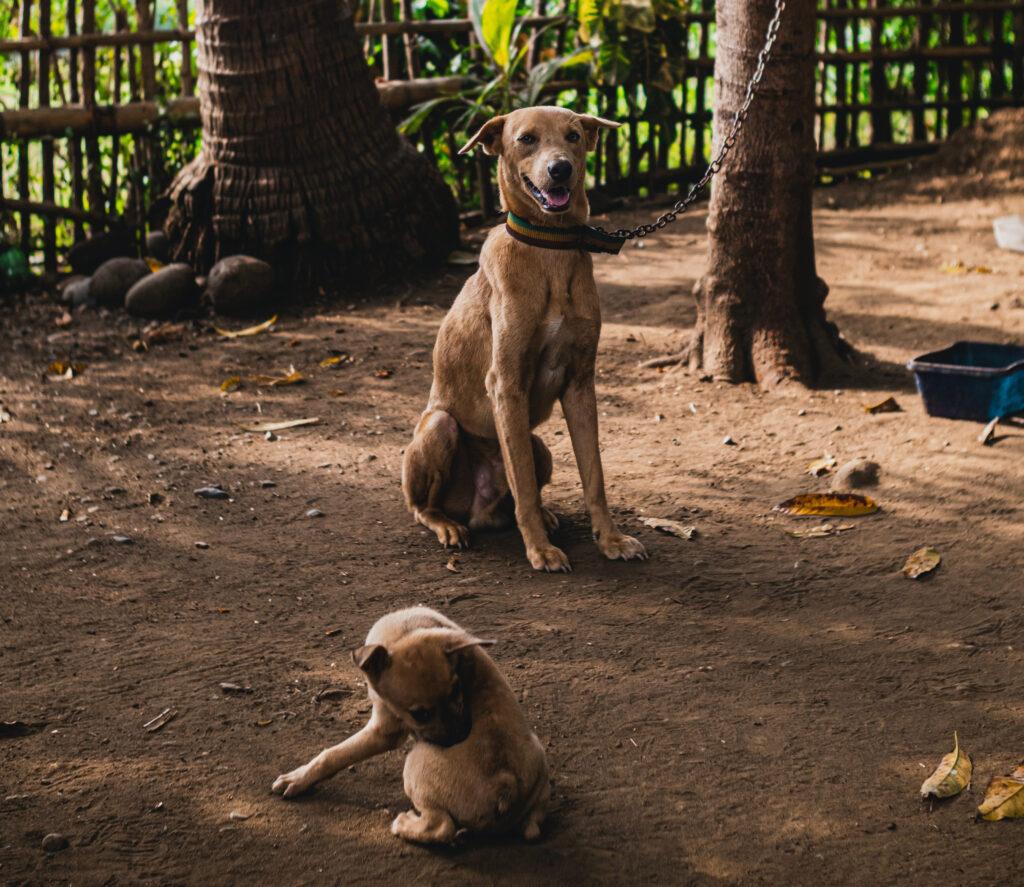
Choose a breed carefully. If, for example, you have a small breed older animal, and bring home a large breed puppy, there is going to be some potential to be injured. Puppies, as part of play, will try to jump on the other dog’s back. This is their natural tendencies trying to establish dominance. Well, if your poor older animal has hip or knee issues, you can imagine that this may not be the best case scenario. Thus, it is important, to only let them have supervised play times, and not be left alone to rough play all the time.
This is especially true if your other pet has a recovering knee injury. Not only is it going to be tough to get that knee to recover with a puppy wanting to play, but the puppy will also be very curious about this really cool chew toy on their leg! So, again, supervision at all times is going to be needed. I’m not saying you can’t get a new puppy, but think the scenarios through before you adopt. Or, perhaps look into adopting an older doggy instead of a new puppy.
Puppies are going to be growing and teething for at least a year, if not more. This means their energy will be high, and your injured dog’s tolerance for this may be low. Make sure you have the means to keep them separated when you are not home or there to supervise, because that would not be otherwise fair to your older injured dog.
Get lots of fun distracting toys for the puppy to play with (and don’t forget your older pup!). This really helps keep them distracted, and happy. If your older dog has a posh brace on, to support a CCL injury, it is ok to have them play for a little while with the puppy, but only directly supervised. The brace does act as a shock absorber, so a little play is ok, but no running or jumping while playing. My puppy likes to stand up on her back legs to “box” with my other dog. This would not go over well if my other dog had an injured leg.
Again, feel free to check us out at poshdogkneebrace.com, or email us through our contact form or visit us on our Facebook page.
Read reviews check out our Google Reviews online. Click Here
Hey guys, this is Nikki, Lead Veterinary technician with Posh Dog Knee Braces. Today let’s talk about puppies! Who doesn’t love puppies, right? All those little sharp teeth chewing on everything😊 Well, this is the best time to get your new puppy used to people and being handled.
First, never force your puppy to do something, or yell and be cross. The literally have a 30 second memory, so they just know mom or dad is yelling, and no idea what they did wrong. Never every hit your puppy, especially in the first few months of growing. Puppies have 3 very important learning times right around 8, 10, 15 weeks where they are the most sensitive and receptive to negative behavior from us. This is when we need to be really gently, soothing voice, and friendly with them, even if they just chewed up your favorite pair of shoes!
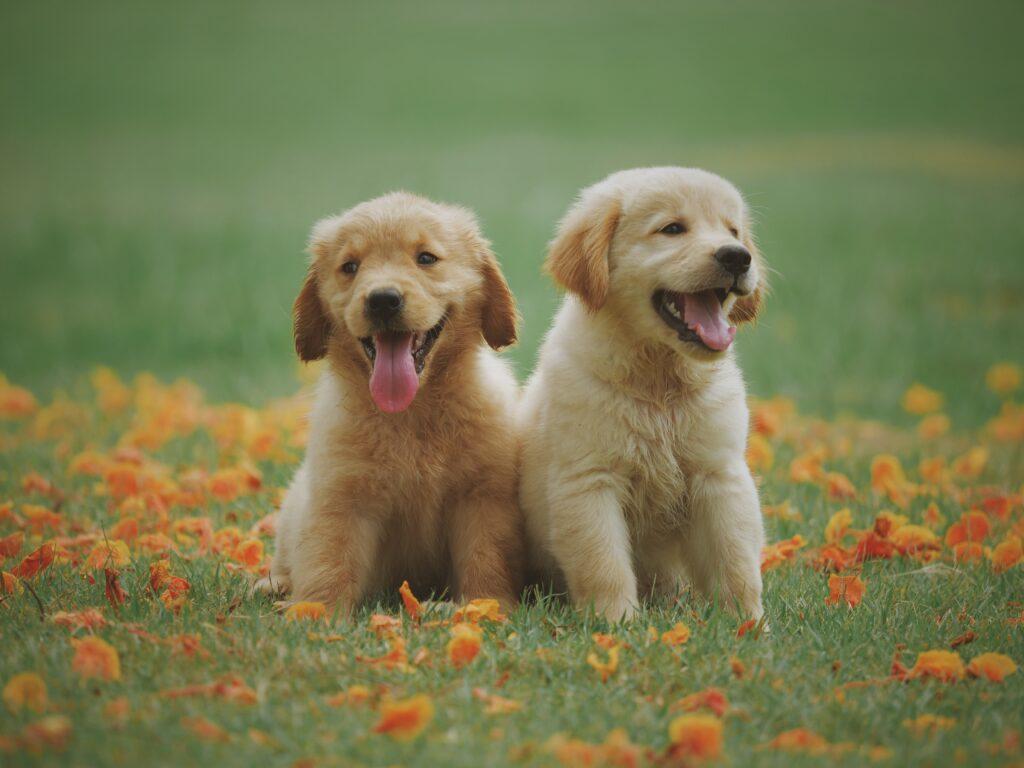
Start with a treat, or a few treats, that your puppy likes. Puppies want to please us, and are very food driven! Even peanut butter smeared on the wall for them to lick is great. Offer them a treat in one hand, and with the other hand gently touch their ears, massaging the tips, and work down to their toes. Spend at least 5 minutes a day giving them treats in replacement of you touching them on toes/feet/legs/ and ears. Especially if you have a floppy eared dog like I do, as they can be prone to ear infections.
This will really be helpful for you in the future. They will trust you and others to touch them, or for the veterinarian to complete their exam. I personally love puppy training classes, as they socialize your dog to other people, dogs, and get them even more bonded to your family in a safe environment. Little dogs tend to be nervous as it is, and can be nippy with toe nail trims. This can all be avoided if you take the time as a puppy to get them used to touch and other people.
Once your puppy is used to you touching their feet without flinching them back, start bringing out the toe nail clippers. Just let puppy sniff, and give them a treat. Then maybe try to do one nail, and treat right away. Do not force your dog to do all their toe nails at once, especially if they are afraid. This is a great way to make a toe nail fear biter, and cost you a lot in grooming fees.
Desensitization can be helpful now, because if your puppy grows up and unfortunately gets a CCL tear someday, putting something on their leg like our brace will be no problem, because you have set them up to succeed!
Feel free to email me at poshintake1@gmail.com with any questions, or visit us at poshdogkneebrace.com you can also check out our Facebook page.
Read reviews check out our Google Reviews online. Click Here
Today I would like to talk about recommended activity levels with a brace or CCL tear. It is still important to remember that this is not a race.
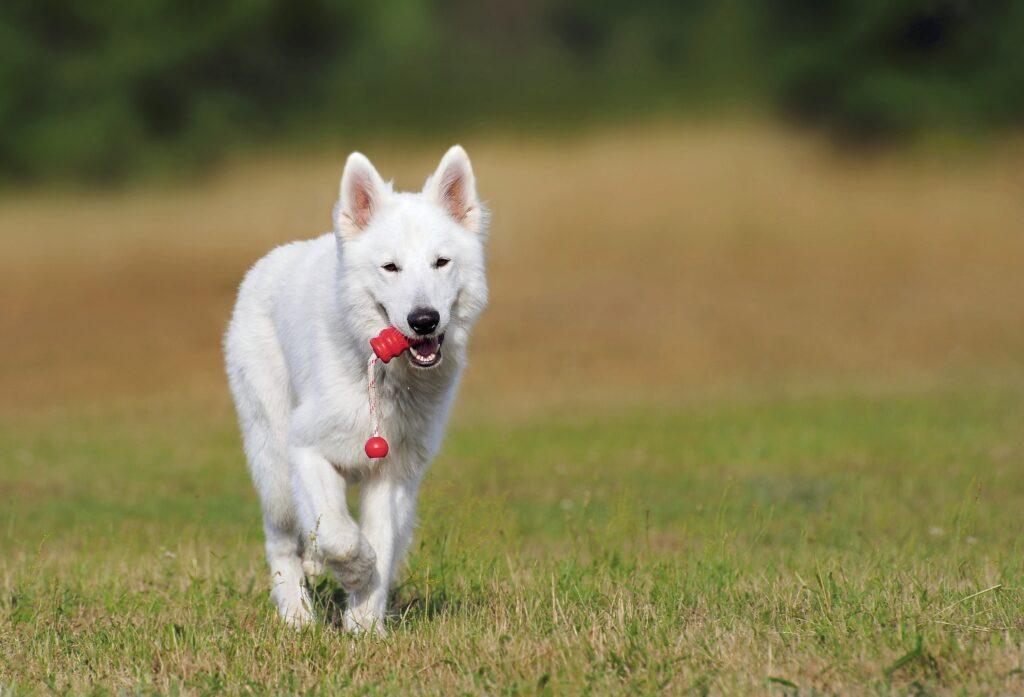
Initially, we start with walks and light physical therapy and massage. Gradually, we can increase activities, such as adding hills or inclines to the walk, sit stands, more muscle building activities.
It is not recommended to let your dog run off leash while in recovery. This can lead to injury of the other leg potentially. Braced walks are meant to be nice and slow, not a jog. The goal is to have your dog placing full weight down on his leg. If you walk or run too fast, they will skip and not place full weight on the leg.
We will get to a point where your pup can play off leash, but ask first, and take things slow. Feel free to email or send in a contact request with any questions about what levels of activity is right for your dog, we are happy to help! You can reach out to use through our contact form or visit us on our Facebook page.
Give Your Dog a Big Hug From Us!
Nikki, Posh Lead Veterinary Technician
Read reviews check out our Google Reviews online. Click Here
Today let’s talk about how to train your dog to use or walk with the brace. First, I want you to use just the hock wrap, to let your pup get used to having something on his ankle. Do this for 30 minutes on and off the first couple of days.
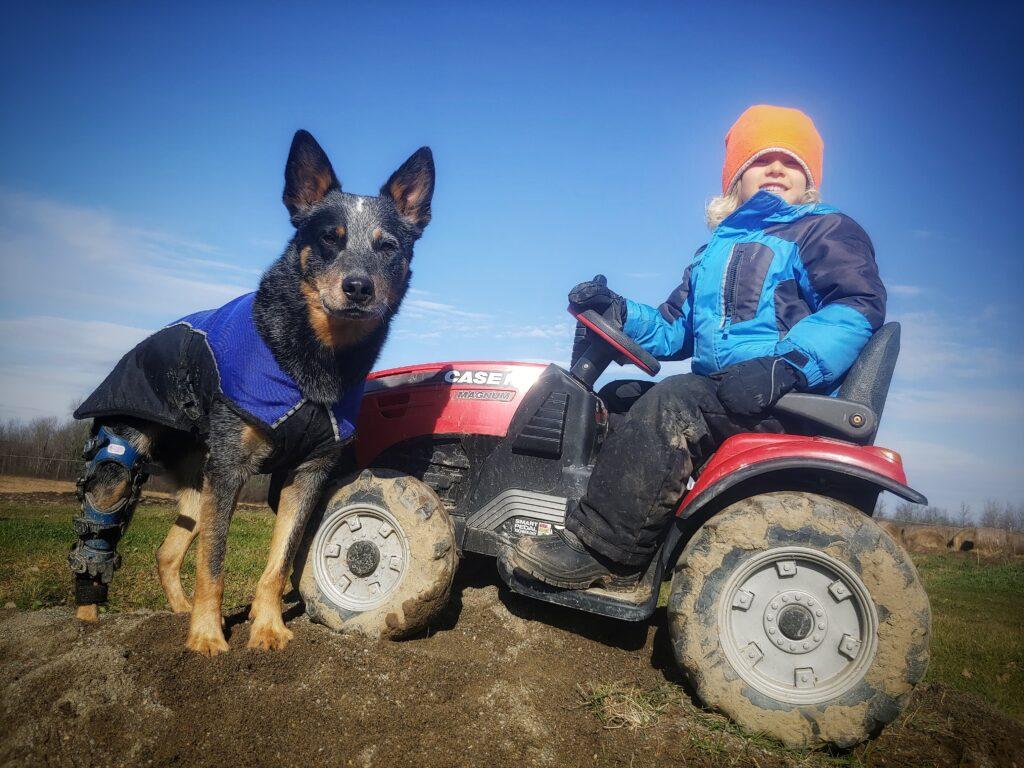
Next, I like to freeze peanut butter in a dish, and distract my dog while fitting the brace on, this will help train your dog to get used to you putting the brace on him.
Once you have a brace on, go directly outside and walk. Then, remove the brace when you come in. Distraction and treats work great while getting your dog used to wearing the brace.
Soon, your dog will link the brace to getting to go out for a W-A-L-K, something really fun.
Then, you can increase the wearing times as stated on our physical therapy handouts. Let me know if you have any questions you can contact us through our contact form or reach out to us on our Facebook Page.
Read reviews check out our Google Reviews online. Click Here
I want to talk about possible home hazards today, and things that we can do to make the recovery process smoother for our dogs. The first home hazard thing that I want to discuss is slippery floors. Our poor dogs trying to walk on slippery floors can have a real challenge. They are usually digging in those nails, slipping, and can cause a real injury.
Commonly we see groin sprains, muscle tears, and even CCL tears from this. Even with a brace on, they could injure the other leg, so it is a really good idea to cover those slippery floors for our dogs who are injured. You can also separate the carpeted area from the slippery part with child gates or something to block them from walking on the slick floor. Then you can leash walk them very gently through that slick area.
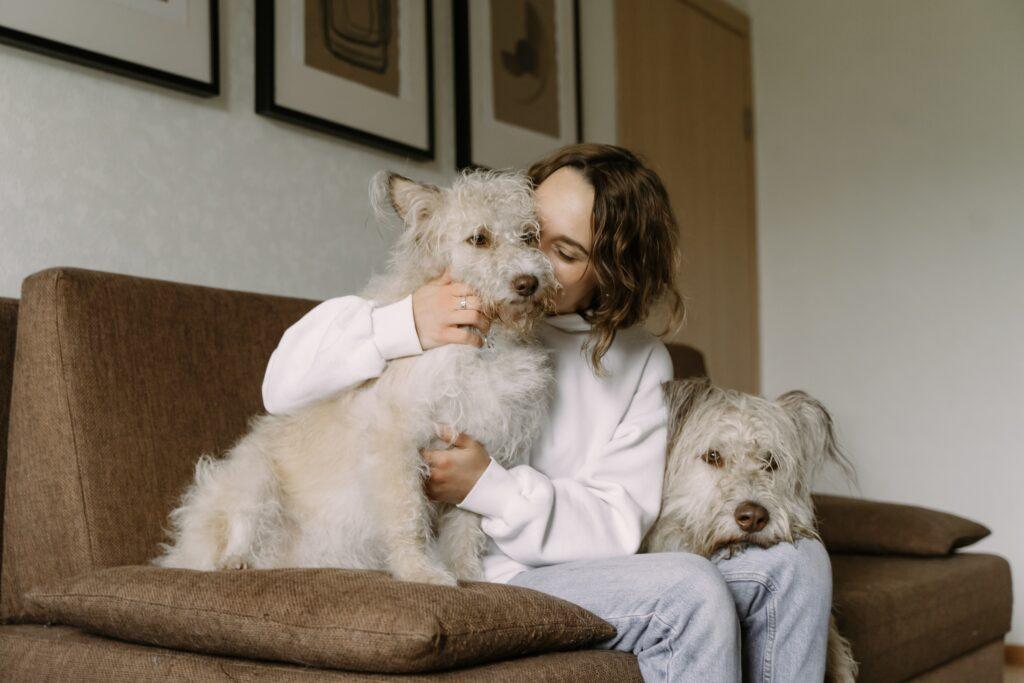
Another thing to do is put carpet down, with runners on the bottom. This is usually the easiest, and gives your pup a pathway that they can go from room to room.
Also, there is a great product called Dr. Busby’s Toe grips. These actually go onto the dog’s toenails, and give them full traction for slick floors. This way they can go through the house without worry, and will keep them from slipping and sliding. You can try dog shoes or boots, but usually dog’s don’t like having something around the foot area. Toenails they usually don’t mind, but the foot pad is sensitive.
When your dog is going up the stairs, they are using those back legs to push off. It is really important, if you don’t have a brace yet, to use a sling to help your dog up the stairs. Going down the stairs is not as big of a deal, as they are using more of their front legs, but I would still like to have either a sling, or a leash, to make sure they are taking things slowly.
Lastly, let’s talk about dog doors which is another hazard. If your dog has free access to going outside with a dog door, please block this off during the recovery process. You can also fence off a small area in the grass, so they only have a small area to go to, but trying to go through the door with a brace on is not a good idea. I know they are convenient, especially when we are gone, but please don’t let a dog have access during the day with their brace on, or injury could result.
Again, please let us know if you have any questions about way to protect your dog from these home hazard, we are happy to help! Contact us on our contact form or visit our Facebook Group.
Read reviews check out our Google Reviews online. Click Here